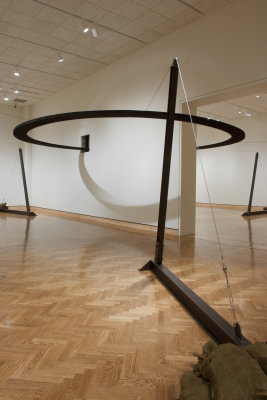Dark Matter: Rollin Marquette at MIA
Glenn Gordon reviews "Rollin Marquette: New Sculpture," in the Minnesota Artists Exhibition Program (MAEP) Galleries at the Minneapolis Institute of Arts through March 18. It's spectacular.

The tension in the air is visible from the moment you walk into Rollin Marquette’s powerful sculptural installation, “Untitled,” showing through March 18 in the MAEP Galleries at the Minneapolis Institute of Arts.
The work consists of a mysterious flat black ring about 16 feet in diameter suspended 9 feet off the ground. At one point along its circumference the ring passes through the wall that separates the MAEP’s two galleries. Not content to do an installation politely tailored to the galleries’ dimensional and architectural constraints, Marquette commandeered the two spaces and forcefully linked them, piercing the wall that stood in the way.
The ring levitates by means of thin steel cables that run out to masts of welded structural steel. The cables pass over pulleys atop the masts, and are then tensioned by turnbuckles down near the rear of the I-beam bases that both support and brace the masts. The tension on the cables is so great that the beams must be weighted down with burlap sacks full of steel scrap to keep them from bucking off the floor.
The eight masts, angled slightly back from vertical in a manner expressive of hauling a line tight to make it fast, are not evenly spaced or equidistant from the ring but deployed so as not to obstruct the galleries’ archways and partitions. Each mast is positioned at the farthest point possible from the ring given its particular position in the square room. The length of each cable is therefore different, but the cables are all tensioned or tuned in unison to keep the ring balanced, level, and steadily aloft. Every force dynamically counteracted by another force, the structure all but hums. Pluck the cables and you can hear it.
I’ve heard critics say that it’s uncool to ascribe any narrative intent to art like this—art purely about its own structure and site–but to me this sculpture is inescapably figurative and metaphorical as well. The hovering ring, which you’re free to stand under, has the distinct form of a halo, as halos were depicted in medieval and Renaissance painting (the MIA’s collection is replete with examples.) Classically, halos were usually golden and radiant. Ours being a dark time, this one is clad in a material so dead-flat black that it does the opposite: it drinks up the light, to such an extent that when you stand beneath it, it’s hard to make out the details of the material its faced with–a needlessly fussy mosaic surface composed of the charred end grain of hundreds of small blocks of balsa wood. The self-conscious choice of charred wood aside, Marquette’s dark halo hovers overhead not through an act of faith but by means of the wonder and menace of physics, clearly and coolly explicated. Strung taut on their masts, the eight cables are a chorus of one-string lyres or harps that must sing night and day without cease to keep the ring suspended.
The saints of the past all a safe distance away in other parts of the museum, Marquette’s use of the two galleries of the MAEP speaks to the era that we live in now, the Epoch of the Engineers. His choice of man-made uniform materials like steel and aluminum aircraft honeycomb (the core of the ring), and his workmanship–the precision of the welds, the care shown in the design and fabrication of every detail of the steel, down to its leathery sheen of wax—aestheticize and fetishize industrialization. But the lumpy burlap sacks heaped like sandbags against disaster at the end of each I-beam counteract an otherwise cold construct with something indeterminate, improvised, uncertain, organic, transforming what might have been a pro forma exercise in engineering into a drama that thrills to the play of forces not fully known.